Time: 9:30AM – 12:30AM; 2:00PM – 4:00PM, 7:30PM – 8:45PM
Location: Upstream from Aspen Glade Campground; next to Conejos Campground, next to Aspen Glade Campground
Fish Landed: 14
Conejos River 06/30/2012 Photo Album
As I described my trip to the Conejos River last July, I convinced Jane to accompany on a camping trip in 2012 so we logged on to the campground reservation site and reserved campsite no. 2 for the weekend of June 29 – July 1. This was the exact campsite I’d enjoyed on my July 2011 trip.
I didn’t work on Friday morning so I could shop for some needed food and then pack the Santa Fe. Everything was set by 2:45PM and I drove downtown and picked up Jane near her office, and we continued from there to interstate 25 and drove south to Walsenberg and then crossed La Veta Pass to Alamosa, and then south again and eventually west to our destination. We arrived at our campsite by 8:15 and had a bit of daylight to set up the tent.
On Saturday we drove back down the highway to Mogote to the Conejos River Angler fly shop. I purchased some flies and asked for advice from the young man running the store. He claimed the river was fishing well from top to bottom and mentioned that green drakes and pale morning duns where hatching in the morning. We returned to the campground where Jane made oatmeal with bananas and blueberries. As the river was supposedly fishing well in the area of Aspen Glade Campground, I decided to forego driving to another spot and began fishing from the lower level of the campground.
I hiked up the river on the path for .2 miles or so and then dropped down to a fishy looking stretch with boulders and nice pockets of moderate depth behind the large rocks. I tied on a yellow Letort hopper hoping to imitate golden stoneflies and added a salvation nymph (previously I referred to these as rubber leg pheasant tails). I covered the nice pockets with this combination to no avail, so I switched out the salvation for a beadhead hares ear nymph, my standard go to fly.
This seemed to improve things, and I began catching small brown trout in the 6-9 inch range. I moved along fairly quickly fishing close to the bank in likely spots and built up my fish count, but I was quite disappointed with the size of the fish. After a half hour or so I reached a nice spot with the current leaving four feet of soft water toward the bank. Here I shot a 15 foot cast to the top of the pool and the hopper dipped and I set the hook on a heavier fish. How heavy I’ll never know as the fish slipped the hook as it moved sideways into the heavier current.
After catching a few more small browns, I reached a nice bend pool and decided that I should be going deep with weight and nymphs in these deeper juicy spots. The sun was now blazing and it was getting quite warm, but I was comfortable when I was standing knee deep in the river. I added a thingamabobber to my line along with a split shot, beadhead hares ear, and beadhead pheasant tail. The beadhead pheasant tail began producing small fish and I moved upstream to a nice wide run on the opposite half of the river across from a massive summer home. By now some big dark clouds moved in and blocked the intense rays of the sun, and I began to notice pale morning duns taking flight on a very sporadic basis. Good I thought, as the pheasant tail nymph is a strong imitation of the nymph stage of pale morning duns.
On a drift along the current seam in the wide run mentioned above, the indicator paused, I set the hook and was fast to another heavier fish. This fish rushed downstream and made a sudden turn and once again the fly slipped from the jaws of a decent fish. I was beside myself for missing my best opportunities to catch decent fish. To move further upstream I needed to climb the steep bank and go up and over some huge rocks with vertical walls extending into the river where the current splashed intensely against the red wall. I built my fish count to nine with most taking the beadhead pheasant tail by noon, and the sun reappeared and beat down on everything beneath. I decided to make the long hike back to the campsite and have lunch with Jane.
While eating lunch I began to doubt that the hatches would occur on the Aspen Glade water, so I asked if Jane would accompany to the upper water next to dirt road 250. The shopkeeper suggested driving up the dirt road to Spectacle Lake or Conejos Campground and to fish in those public areas. This what we decided to do, and I remained in my waders while driving seven miles on the paved road to the turn onto 250, and then another six miles on a fairly rough dirt road to the Conejos Campground. I backed into an unoccupied campsite and left Jane reading her Kindle in a folding chair.
I crossed the river at the campground and walked up the opposite side and began fishing with the nymphs that remained on my line from the morning. Nothing was exhibiting interest, but a huge quantity of stoneflies were flitting up from the grass with each step that I took. I caught one and noticed it had a very light olive/tan underbody with a tinge of orange color near the tip of the abdomen. I decided to tie on my yellow Letort hopper even though it was much too bright to match the stoneflies present in the grass and willows. I added the tried and true beadhead pheasant tail as my dropper and continued fishing attractive spots along the bank. The water here wasn’t as attractive as the lower river with many more wide shallow stretches. At one point I swapped the yellow Letort hopper for an olive body stimulator of approximately the size of the naturals.
This fly was about as good an imitation as I had, but it failed to produce as well. I’m not sure if this was because the stoneflies were not getting in the water or if the imitation wasn’t close enough. I noticed the olive body got fairly dark when it got wet and there was no hint of orange in the fly. I decided to go back to the yellow Letort hopper as it was easier to see, and there were also quite a few small hoppers present along with the stoneflies.
I could now see my upstream progression was going to end as a large wire stretched across the river marking the end of the public water. But just below the wire there was a nice long pool created by the main current deflecting off a large rock along the bank. I cast the two fly combination to the top of the pool and allowed the hopper and trailing nymph to float back toward me along the current seam. Wham! The hopper dipped and I set the hook and a heavy fish shot downstream in the heavier current toward the middle of the river. I let it run quite a ways downstream and followed it a bit when it finally stopped. I reeled rapidly and regained line, but it made a couple more surges downstream. Eventually I gained ground and reeled the fish back toward me when it made an upstream move. I could now see a rainbow trout in excess of fifteen inches, and I was excited to bring it to the net. By applying side pressure I was able to bring the fish directly across from me perhaps five feet away, when it decided to make another strong run downstream. I allowed it to make the strong initial surge, but then as I regained some line, the fish made a strong reversal and my line suddenly went limp. I reeled up my line only to discover that the knot attached to the top fly, the Letort hopper, had broken. Once again I was foiled in my attempt to catch a substantial fish on the Conejos River.
After shrieking in disbelief, I retreated back downstream to across from Jane. I gazed downstream and noticed another fisherman with his young son fifty yards below me. I decided to fish the area in between and then possibly circle around. I replaced the yellow Letort hopper with a Chernobyl ant and tied on a new beadhead hares ear as the point fly. As I fished the water, the man and his son left their spot and walked up along the bank opposite me. I climbed back on the bank and hiked to the area they had just departed where I covered the area with quite a few casts to no avail.
Next I moved downstream to the right channel below a small island where a nice deep run flowed for forty feet or so. I made five or so drifts along the current seam with no results, and then on the next drift I placed my cast more in the current. As the Chernobyl came back toward me it took a dip, and I instinctively set the hook. The fish felt nice and heavy, but initially I was concerned it was a foul hook. That was my luck on this last day of June. But the fish ran downstream and doggedly tried to dive and shake the fly as is often the case with brown trout. The more I played the fish, the more I realized that the fly was in the mouth. Furthermore, it was clear that this was a nice fish as I caught a glimpse of it. The brown made several bursts downstream, but each one was shorter than the previous until I eventually worked it up next to me and lowered the net beneath its beefy body. When I placed the brown in my net to photograph it extended beyond the net opening by about an inch making it a 16 inch catch and made me a happy fisherman.
After releasing the brown I continued downstream, and I my focus was renewed but I didn’t experience any more success despite covering quite a bit of decent water. I was getting rather far from the campsite so I elected to climb up the bank and walk back upstream. I reached a spot where I was close to the dirt road, so I cut over to the shoulder and returned by way of the rough dirt highway. When I turned into the campground I discovered Jane in her chair reading her Kindle. Apparently the campground hosts had stopped and charged her $8 for a day use fee.
We jumped in the car, and covered the six miles of gravel and washboard back to the paved road and then on to Aspen Glade. Jane and I relaxed with some beverages and then had a fantastic dinner of shrimp stir fry after which I suggested we go back down to the river to view the sunset. I took my fly rod and frontpack, but decided to not climb back into my waders. We arrived at the river by 7:30 and sat on a nice wide rock and observed. There were numerous clusters of caddis dancing over the water, but nothing was showing on the surface for perhaps half an hour or so. Finally we spotted a few rises directly across from us near the main center current. I caught one of the caddis and it appeared to be a size 16 body with a size 14 wing. The abdomen was a very light yellow color so I tied on a light gray deer hair caddis size 16 and began casting where we had spotted the rise.
Nothing was taking my caddis, but another fish rose a bit higher up along the current seam so I tossed a cast there, and sure enough a nine inch brown rose and sucked in my caddis. I was pretty pleased with this bonus fish, but no additional fish revealed themselves so I sat back down on the rock to observe with Jane. Fifteen minutes passed and as the sun fell below the horizon a fish began rising in the tail of the pool. Jane actually spotted the rises first. This required a very long cast across and downstream, and I needed to angle myself to allow an open backcast of a lot of line. I began working out line and shot some casts close to the position of the rise, but the drift was very brief until the current introduced drag to my fly. I made perhaps ten casts with no success and decided to sit down and observe again.
Jane was beginning to feel chilly, so she returned to the campsite while I continued watching the pool in silence. Sure enough as the light began to wane, a fish rose in the tail area again, although it seemed to be in a lane five feet closer to me. Once again I walked to the edge of the river and worked out line and then shot a cast in the vicinity of the rise. No luck, so I stripped in some line, backcast and shot a longer cast to the same area but a bit further out. In the next instant a fish sipped in my fly and I made a quick strip set. I couldn’t believe what just happened! The fish pretty much hunkered down, and I began reeling line and it swam willingly upstream. Judging from the weight, it was a decent fish. When the fish was across from me it began to fight my efforts with more authority, but after a few thwarted runs, I brought it into my net. This fish wasn’t quite as long as the one by the Conejos Campground, but still a good 14 inches. This was icing on the cake for me, and I was very pleased to have landed a fish off of a long cast, an unusual accomplishment for me.
I photographed and released my long distance catch and returned to my rock hoping to see more late surface activity. Sure enough some fish began to rise on the other side of the main midstream current across from and slightly above my position. I made a few casts with no success and then spotted a large brown object moving downstream to the area I was casting to. As I watched the beaver made a sudden dive as it descended and arched its tail and brought it down flat on the water creating a loud smacking sound. What a thrill to see a beaver on the Conejos River at 8:45 on Saturday night.
The beaver disturbance ended my fishing and I was feeling chilly as well, so I clipped my fly to the rod guide and returned to camp.

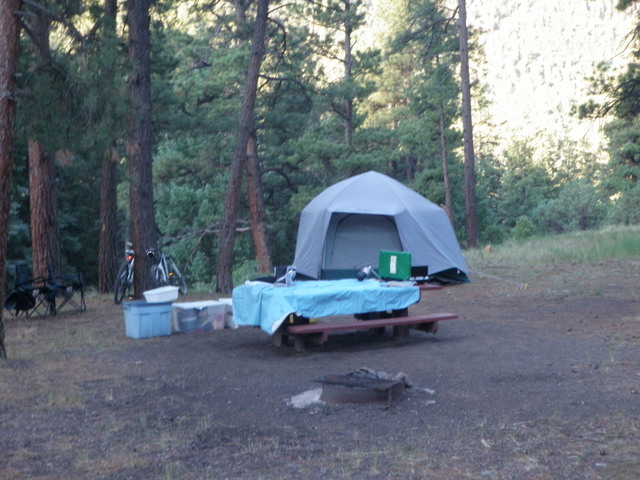
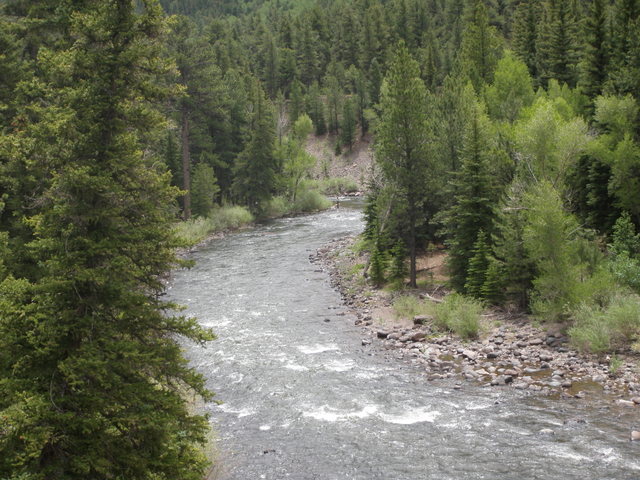
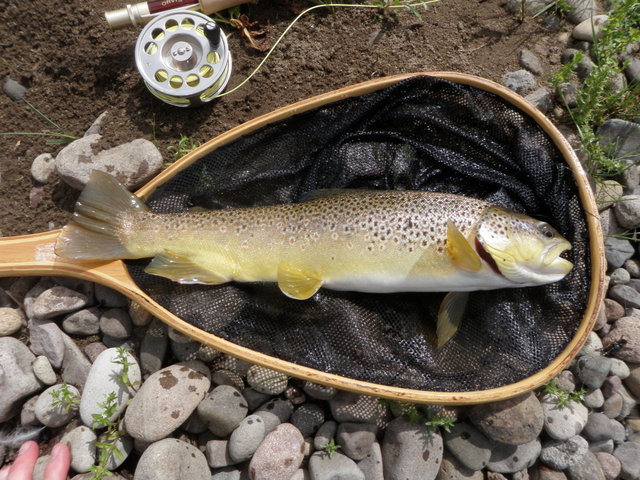
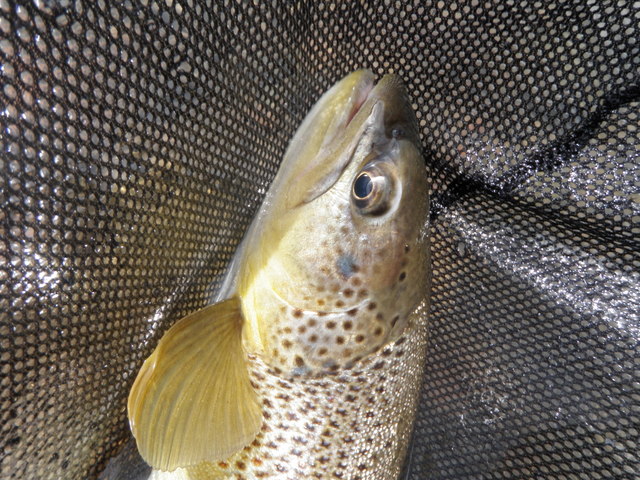
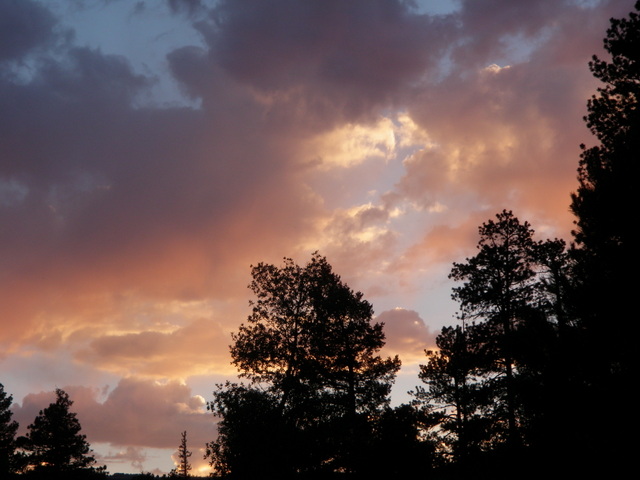
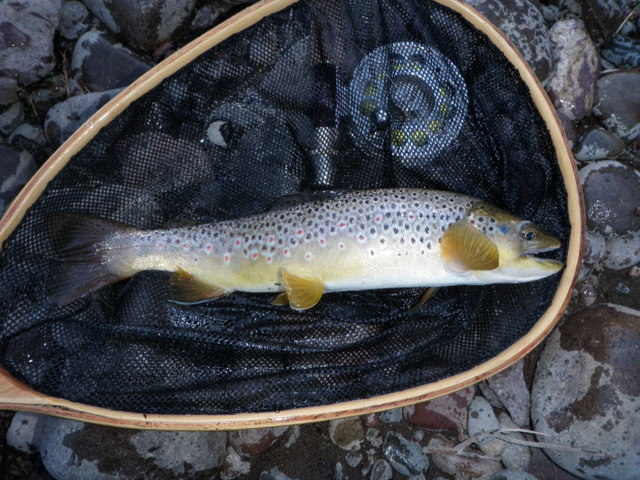
The Conejos valley is a pretty special place. Nice brown!